Bird Watching Binoculars Buying Guide

In This Guide We Cover
- Types of binocular: porro prism versus roof prism
- Binocular magnification: bigger is not always better
- Binocular brightness
- Field of view
- ED or HD glass
- Close focus
- Lens and prism coatings
- Weatherproofing
- Balance, handling and durability
- A word about weight
- Eye cups and eye relief
What To Look For In a Birding Binocular?
Whether you’re buying your first pair of birding binoculars, or looking to upgrade an existing pair, shopping for binoculars today can be a bewildering experience. With so many options to consider, and so many models to choose from, where on earth do you start?
Here at Stealth Birding, we know binoculars, and we’ve pooled our knowledge and expertise to bring you this handy binocular buyers guide. We cut through the marketing hype and technical jargon, providing exactly what you need to make an informed decision about the right birding binocular for you.
Focus On Your Ideal Binocular
When shopping for binoculars it’s vital to remember that the relationship between a birder and his or her optics is a very personal one. What’s perfect for me may not suit you at all, and vice versa. There really is no such thing as one universally ideal birding binocular -- it’s all about finding that elusive blend of features and performance that suits your particular needs within your budget.
As you consider the rest of the points in this guide, always bear that in mind, and apply the advice based on what you need from your binocular.
Types Of Binocular: Porro Prism Versus Roof Prism
Perhaps the first thing to decide when narrowing down the field of possible binoculars on your shortlist is to select the type you’d like to buy. Binoculars today fall into two main types:
Porro Prism Binoculars
This is the traditional binocular design where the eyepiece lenses are closer together than the objective lenses (the large lenses at the end of each barrel). Prior to the 1960s all binoculars were made this way. In recent times though Porro Prism binoculars are very rairly used by serious birders. This is because they are usually bulkier and ergonomically less comfortable to hold and carry than roof prism binoculars. They are also usually less robust than roof prism binoculars.
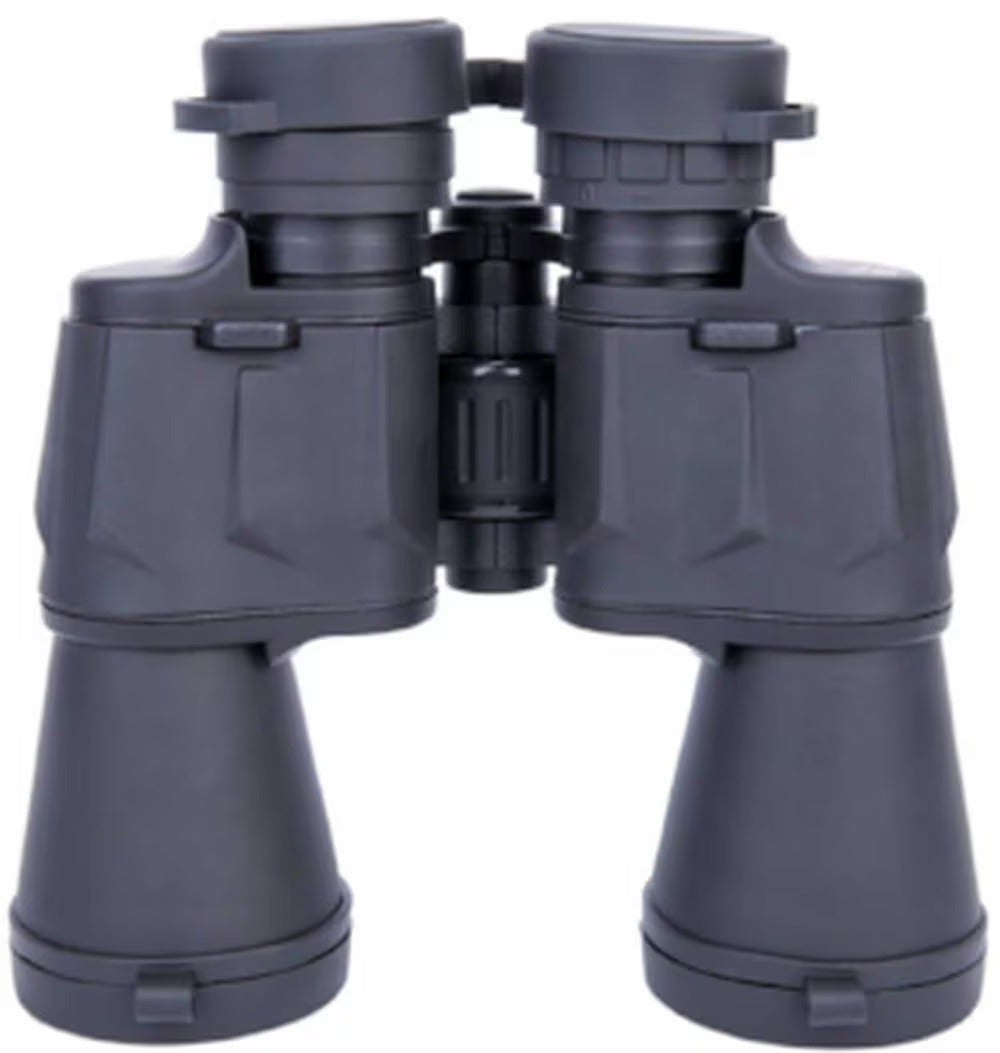
Popular examples of the porro prism design are the Braun binoculars
Roof Prism Binoculars
This more contemporary, straight-barrelled design results in a more compact, sleek looking binocular that is more robust and ergonomic.
- Because of the straight barrels, roof prisms are generally more compact and are more comfortable to use and carry for extended periods than porro prisms.
- Roof prisms tend to be more robust: sealed, nitrogen-purged metal or polycarbonate barrels, often covered in rubber armouring, mean your optical investment is well protected.
Which option you choose is a matter of personal preference, if you’re willing to invest a little more, a high-quality roof prism binocular will generally prove a more versatile all-rounder for birding and wildlife observation in the field.
NB. All of the high-end birding binoculars from leading manufacturers employ roof prism designs.
An example of roof prism binoculars are the NatureRAY Outrek Binoculars.
Binocular Magnification: Bigger Is Not Always Better
Every binocular has two numbers printed somewhere on the instrument (10x42, 8x32, etc.) -- the first of these numbers (before the x) signifies how much the binocular will magnify the view you’re looking at.
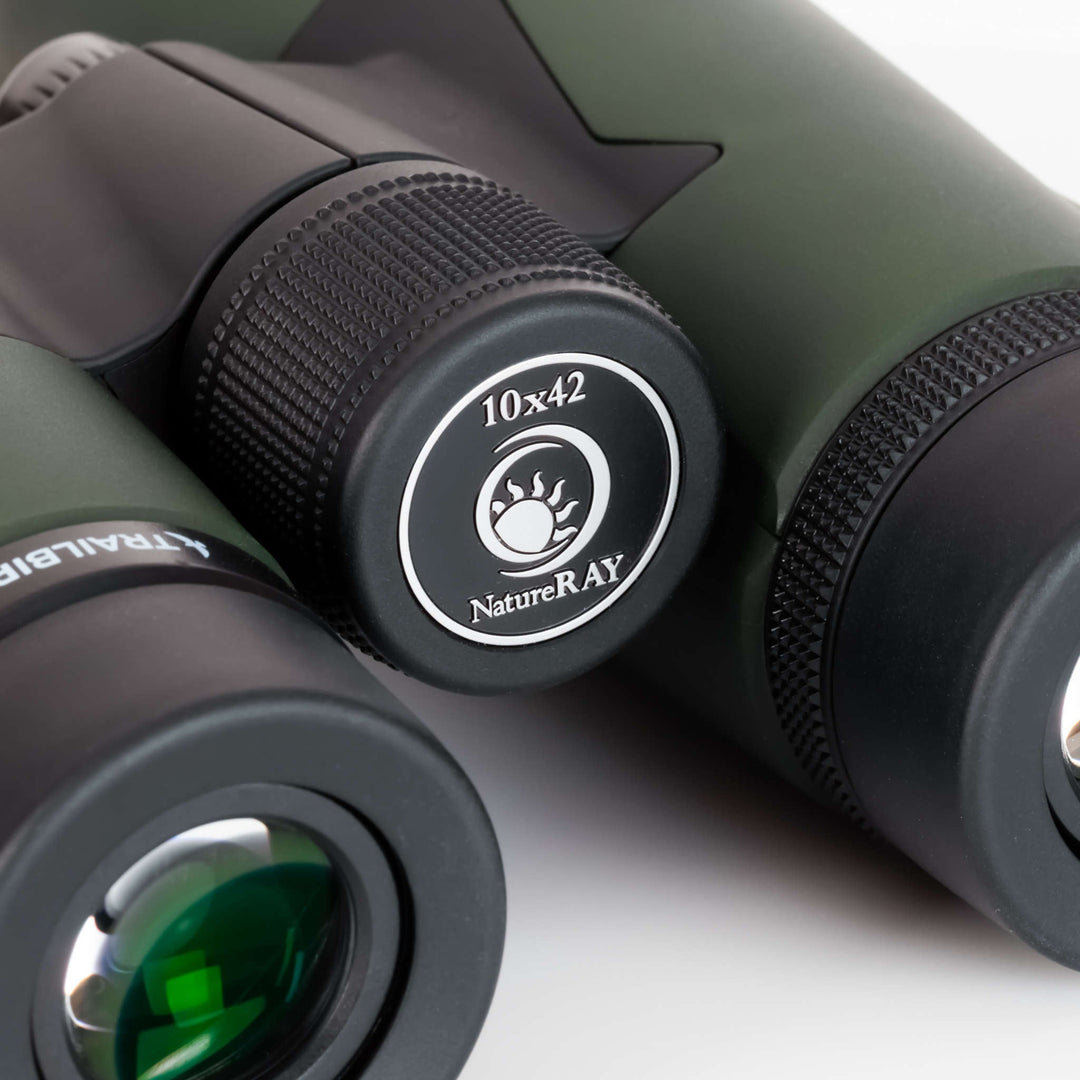
Many first-time binocular buyers make the mistake of assuming that higher magnification is better. After all, the whole point of a binocular is to give you a closer view of your subject, so surely more magnification is a good thing.
Unfortunately, when it comes to optics nothing is ever that simple. While higher magnifications will bring your subject closer, they will also reduce image brightness, decrease focus depth, reduce your field of view and accentuate hand-shake and atmospheric aberration. Magnifying hand-shake can be a real issue, particularly as we get older, so for many people, lower magnifications actually work better.
The sweet-spot for birding and wildlife watching binoculars you can comfortably hand-hold in the field and that can be used in a variety of different habitats, falls between 7x-12x, with 8x and 10x being by far the most popular variants.
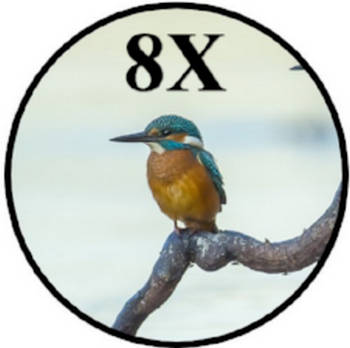
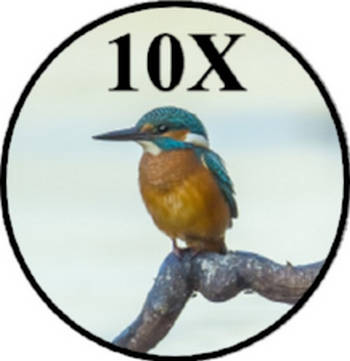
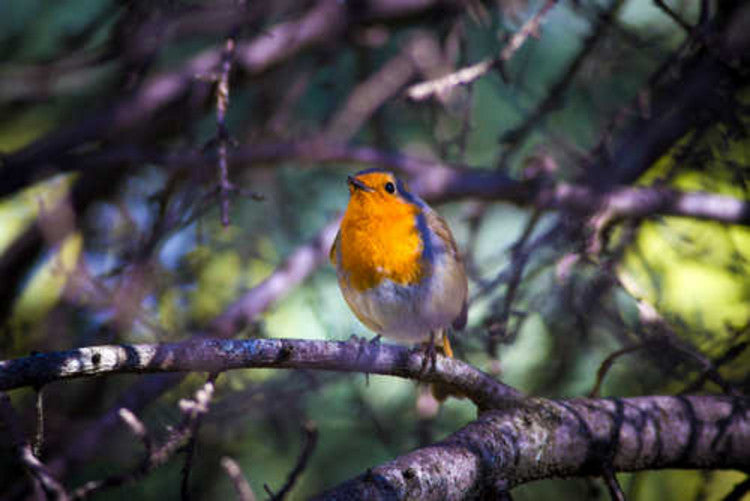
Binocular Brightness
Image brightness is one of the most important things to consider when choosing your new birding binoculars. Birds are often active in the early morning or late evening when the light is subdued. Even in the middle of the day, in shady habitats like woodland, light is often in short supply, so you’ll need a binocular that can deliver a bright, clear image in poor light.
The principal factors governing brightness in a binocular are the diameter of the objective lens (the second number after the x printed somewhere on the binocular) and the magnification.
Objective lens diameter: more light in = more light out
Larger objective lenses let more light into the optical system… so binoculars with larger objective lenses have the potential to deliver a brighter image at the eyepiece than those with smaller objectives. There’s a caveat though: as you increase the size of the objective lenses binoculars become steadily bulkier, heavier and more expensive.
In practice, for a binocular you want to carry with you and use in the field, the useful range of objective lens sizes is from 30mm-50mm, with 32mm (mid-size binoculars) and 42mm (full-size binoculars) being the most popular. Smaller “pocket” or “compact” binoculars can be useful in situations where you can’t carry a larger binocular, but are not really suitable as an all-round birding binocular.
Field of View
Binoculars with a wide field of view have a number of advantages for birders. A wider field of view makes it easier to scan large open areas quickly, and makes it much easier to find and follow fast, erratically moving subjects like small birds.
Higher magnification reduces the field of view, but a lot of other factors in the optical design can also influence it. Field of view is measured either as an angle (typically between 6°and 8°) or as a linear measurement of how many metres are visible across the diameter of the field at a range of 1,000 metres (or feet/1,000 yards) and is usually printed somewhere on the binocular.
Optical Quality
The optical design, the quality of optical components and the precision of their manufacture all have a huge impact on the quality of the overall image you see through a pair of binoculars. Here are some of the factors that contribute to the overall quality of the view through your binoculars… and features you should look out for when choosing your next birding binocular.
ED or HD Glass
ED (Extra-low Dispersion) or HD (High Density) elements in the objective lenses of some high-performance binoculars are designed to improve resolution and contrast by reducing or eliminating a phenomenon known as Chromatic Aberration (CA), which can cause a bright colour fringing to appear around high-contrast subjects when you look through binoculars
Images through binoculars with ED/HD elements in their optical system tend to appear crisper, more defined and have truer colour fidelity across the spectrum -- resulting in a more natural, realistic image that’s ideal for birding.
Close Focus
Another aspect of the optical design that it’s important to consider is how close your binoculars can achieve sharp focus. Most contemporary binoculars will focus as close as 2m or closer… but some, particularly at the lower end of the market, may have a specified close-focus distance of 3m or more, and some can focus as close as 1.5m or less.

Generally, for birding, 3m isn’t an issue, but if you’re likely to use your binoculars to look at insects (dragonflies and butterflies, for example) or to get a closer look at inaccessible wildflowers on the far side of a ditch or fence, then close-focus could be more important for you.
Lens and Prism Coatings
High performance anti-reflective, high-transmission coatings are critical to the design and performance of contemporary optics. The quality of the optical coatings is one of the key differentiators between mediocre binoculars and truly outstanding ones.
All binoculars on the market today employ some form of coating on the lenses and prisms to improve light transmission and reduce internal reflection. These coatings vary enormously from manufacturer to manufacturer, and at different price-points in the marketplace, but broadly speaking binoculars sold today are either:
- Coated: some, but not all air-to-glass surfaces in the optical system have a special coating applied to them.
- Fully-coated: all air-to-glass surfaces in the binocular have a special coating applied to them
- Multi-coated: some air-to-glass surfaces in the binocular have multiple layers of coating applied to them
- Fully-multi-coated: all air-to-glass surfaces in the binocular have multiple layers of coating applied to them
For serious birding and wildlife observation NEVER consider buying anything but fully-multi-coated optics.
Anti Reflection, High Transmission Coatings
By applying layers of anti-reflection, high-transmission coatings to optical surfaces, manufacturers optimise the transmission of visible light through the binocular’s optical system, minimising internal reflection, and delivering a brighter, sharper more defined image at the eyepiece. The very best anti-reflection coatings are expensive and technically difficult to apply evenly, adding considerably to the cost of the finished binocular, but dramatically improving its performance.
Phase Corrected Roof Prism Coatings
The way roof prism binoculars work means that the light passing through the optical system is split and then recombined as it passes through the prism system. These separate light paths end up “out of phase” with one another, resulting in less contrast and detail in the recombined image.
To combat this “Phase Shift” good roof prism binoculars will have a special Phase Correction coating applied to the prism surface to correct this phenomenon.
Roof Prism Mirror Coatings
The roof prism design also requires a special reflective mirror coating applied to one of the prism surfaces to reflect light through the prism system to the eyepiece. The higher the light transmission of this mirror coating, the brighter the binocular will appear in low light situations.
The three most commonly applied mirror coatings, in order of increasing brightness (and cost), are:
- Aluminium mirror coating: typically result in light transmission of 87-93% through the prism.
- Silver mirror coating: result in light transmission of 95-98% through the prism.
- Dielectric mirror coating: a special coating technique used in very high specification binoculars to achieve >99% light transmission through the prism.
Protective / Water Repellent Coatings
Premium binoculars often have a special high-tech coating applied to external lens surfaces designed to protect the more fragile coatings underneath. These coatings are very tough, to resist abrasion and scratching, and actively repel water and dirt particles, meaning your lenses need cleaning less often, and are much easier to clean when the need arises.
This feature that’s starting to appear in some mid-market binoculars now -- and where available within your budget is something to consider.

Weatherproofing
Binoculars for birding have to be able to cope with whatever the weather can throw at them. Make sure the binoculars you choose are waterproof and fully sealed. As well as protecting against rain, or accidental immersion, this will also mean your binoculars are impervious to dust and other airborne contaminants.
It’s also important to ensure your binoculars have been purged with an inert gas (usually nitrogen but occasionally argon) at the factory. This drives out the air (and the water vapour it contains), eliminating the risk of internal condensation/fogging as your move between dramatically different temperatures (from a warm car, for example, to a freezing lakeshore, or vice versa).
Balance, Handling and Durability
How comfortable a binocular is to hold and carry has a big impact on your enjoyment when using it. The size and shape of binocular you prefer is largely a matter of personal preference.
Traditional Single-bridge
The original roof-prism design with a single wide hinge joining the two binocular barrels spanning most of the binoculars length.
A Word About Weight
The weight of a binocular will, of course, depend on its size, but also on the type of housing/body material used in its construction, and the quality of the optical components it contains. It’s important to remember that while keeping weight down is important, high-quality optical glass is dense and heavy. Binoculars that seem unusually light for their size should ring warning bells about the quality of the optical components inside.
Having a reasonable amount of weight in a birding binocular is desirable for another reason. A bit of weight, and the inertia that comes with it, often helps dampen some of the effects of hand-shake. Counterintuitively, and within reason, weightier binoculars tend to be easier to hold steady than very light ones.
Housing & Rubber Armour
One of the principal components that adds weight to a binocular is the body or housing material. It is also the key component that protects the delicate optical system from the knocks and bangs that are a fact of life out in the field.
So binocular housings need to be lightweight, but they also need to be very strong. The quest for that elusive balance between weight and durability has led to three key materials being used in contemporary binocular construction:
- Polycarbonate: light, very strong and relatively low cost, polycarbonate bodies are typically used in many budget- to mid-range binoculars
- Aluminium alloy: light and very strong metal, many manufacturers employ aluminium alloys in the construction of their mid- to high-range binoculars
- Magnesium alloy: the strongest, lightest and most expensive material currently used for binocular housings, magnesium alloy is generally used on premium models from high end optics manufacturers.
As well as a solid housing almost all contemporary binoculars will have some degree of rubber armour applied to both barrels to protect against minor impact in the field, and also to improve grip and comfort for the user. Sometimes armour will include sculpted thumb indents and textured surfaces to improve the grip and handling of the binocular.
Eye Cups and Eye Relief
Contemporary binoculars feature adjustable eyecups to make viewing more comfortable. Older or cheaper models will have rubber eyecups that can be folded up or down, whereas newer, higher quality models will have plastic or metal rubber-coated eye-cups that twist up and down as required, often with intermediary “click-stop” points in between.
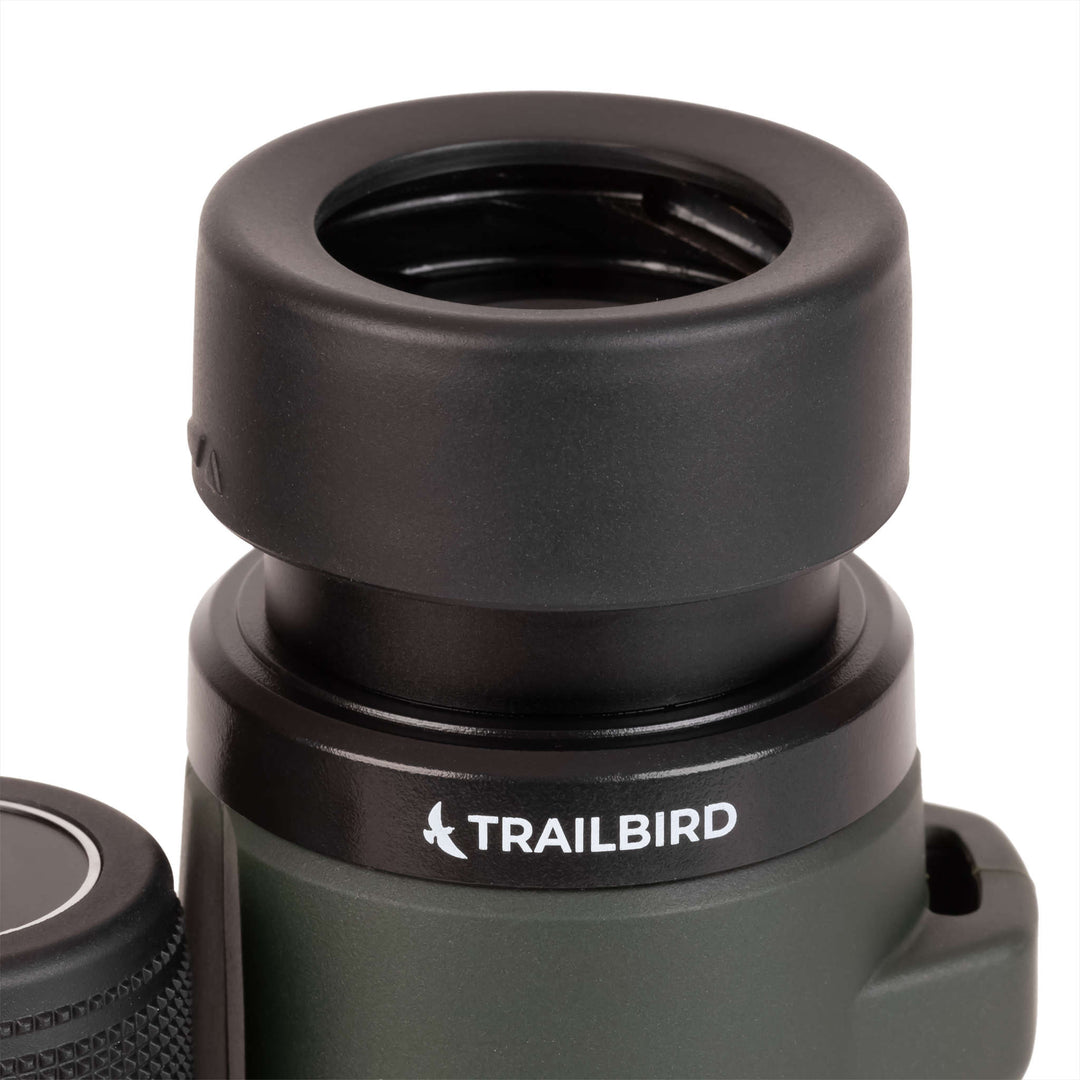
Eye cups help you to hold the binoculars at exactly the right distance from your eyes to see the full field of view comfortably, and shade out external light. For users wearing eye glasses, these eyecups can be twisted all the way down to bring their eyes closer to the eyepieces and allow them to see the full field of view while still wearing their glasses.
Eye Relief
The eye-relief of an optical instrument refers to the maximum distance behind the eyepiece that a user can place his or her eye and still see the full etent of the field of view. When viewing without glasses, you can position your eye wherever is most comfortable within this range (by setting the twist-up eyecups to your preferred height).
For those who need to wear their glasses when using binoculars, having enough eye relief can be critical. Because the glasses have to sit between the binocular eyepiece and the viewer’s eyes, eyeglass wearers need a binocular with sufficient eye-relief to accommodate the thickness of their glasses, and the distance between the inside lens surface of their glasses and their eye, in order to see the full field of view.
If you wear glasses pay particular attention to the eye relief quoted in a binocular’s specs. Long-eye-relief binoculars with a quoted eye-relief measurement of 16mm or more should work well for most eyeglass wearers… however some may find they require a eye relief of up to 18mm or even more to experience the full field of view.
Setting Your Budget - Think Value, Not Price
When deciding how much to spend on your new birding binoculars, it’s important to remember that the cheapest option almost never represents the best value. Investing a bit more in a quality optical instrument is always worth it.
Binoculars are probably the single most important piece of equipment a birder will own. They are something you will use regularly (perhaps every day), and that will continue to repay your investment with exceptional views for many years. Our advice is always to buy the best pair of binoculars you can realistically afford: then to get out and enjoy them, every chance you get.




































